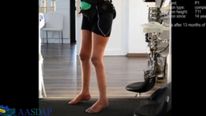
Virtual reality has helped eight paralysed patients regain some feeling in their legs in “a big surprise”, say scientists.
The clinical results of the programme in Sao Paulo, Brazil, show the participants have some sensations and muscle control in lower limbs.
A team led by neuroscientist Dr Miguel Nicolelis, of Duke University in North Carolina, used a virtual reality system which monitored the patients’ brain activity to simulate control of their legs.
The programme helped the participants convert brain activity into electric signals that power brain-controlled robotics such as exoskeletons and robotic arms.
It took seven months before the first encouraging signs were spotted in some patients who joined the Walk Again Project.
After a year, four had their conditions upgraded from complete to partial paralysis because the sensations and muscle control were so strong.
Five of the participating patients had been paralysed for at least five years, and two others for more than a decade
Most said they had better bladder control and bowel function, allowing them to cut back on the use of much-need laxatives and catheters.
Dr Nicolelis said: “To our big surprise, what we noticed is that long-term training with brain-machine interfaces triggers a partial neurological recovery.
“What we didn’t expect and what we observed is that some of these patients regained voluntary control of muscles in the legs below the level of the lesion and regained sensitivity below the level of the spinal cord injury.”
The eight patients spent at least two hours a week using devices controlled through their brain signals.
They wore caps lined with 11 non-invasive electrodes to record their brain activity.
The patients were taught how to operate their own digital likeness in a virtual reality environment.
Dr Nicolelis said they were asked to imagine walking in the virtual world and it appears “the training reinserted the representation of lower limbs into the patients’ brains”.
Physical equipment such as walking devices and overhead harnesses were later added to further test patients’ control over their posture, balance and ability to use upper limbs.
A new trial is also being earmarked to include people who have suffered more recent spinal cord injuries.
[Source: Skynews]


















